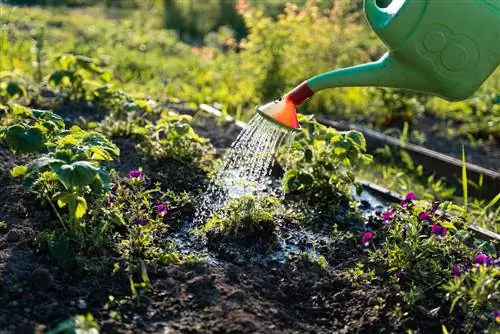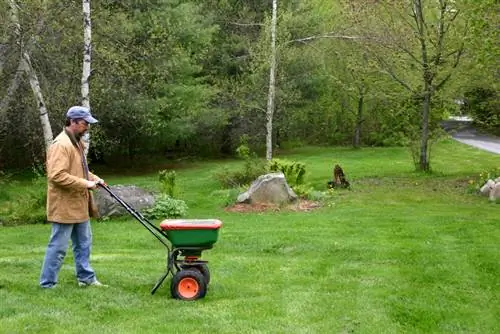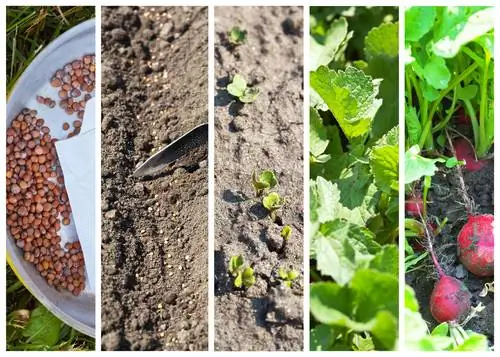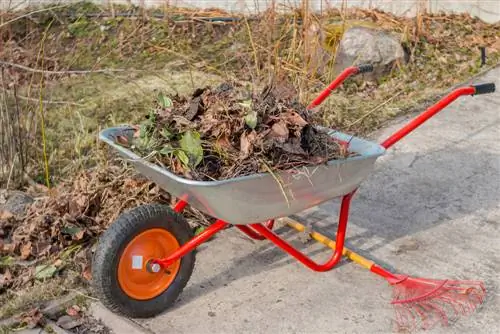- Author admin [email protected].
- Public 2023-12-16 16:46.
- Last modified 2025-01-23 11:22.
One of the main tasks in July is regular watering. It is also the month when the work of spring pays off in the form of a bountiful harvest. This frees up space in the beds that can be used for new seeds. Withered subshrubs such as lavender can be cut back from July to encourage a second flowering.
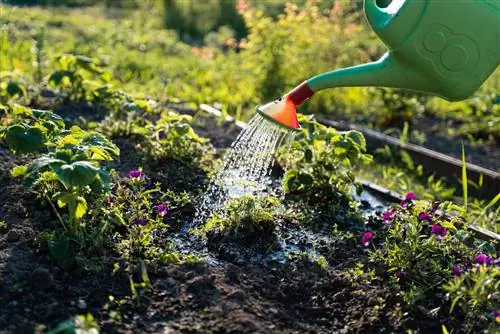
What are the most important gardening tasks in July?
In July, the beds were completely harvested for the first time, except for heavy feeders such as zucchini. Now there is space again for sowing lettuce, radishes, carrots and other vegetables. Herbs can be harvested. In midsummer, watering, fertilizing and mulching are top priorities. After the harvest, for example, peach trees can be pruned.
All gardening work at a quick overview
- Sowing: Bush beans, carrots, winter radish, radishes, beetroot, vegetable fennel, spinach, salads, sugar loaf lettuce, Chinese cabbage, spring onions, winter herbs (parsley, spoonwort, St. John's wort, winter purslane, caraway), biennial summer flowers and perennials
- Harvests: Numerous vegetables, herbs and soft fruits (currants, gooseberries, raspberries, strawberries), cherries and, in warm locations, peaches, apricots and early apple varieties.
- Plants: leftover pre-grown vegetable plants (endive, ice lettuce, lettuce, kohlrabi, kale, savoy cabbage, cauliflower), irises and peonies
- Propagate: Head and shoot cuttings from various garden plants, remove and plant children from strawberry plants, divide irises
- Pruning: Cherry, peach and apricot trees (after harvest!), berry bushes (raspberries, currants, gooseberries), spent summer flowers and perennials
- Other gardening work: Harvesting, fertilizing, watering, weeding, loosening bed soil, sowing green manure, mowing lawns and flower meadows, mulching, fighting or preventing diseases and pests.
Sowing in July
- Sowing outdoors: Asian lettuce, artichoke, basil, borage, broccoli, French beans, Chinese cabbage, dill, endive, coriander, kohlrabi, cress, spring onion, lovage, turnip, chard, carrot, pak choi, lettuce, purslane, radishes, radicchio, radish, rocket, sage, chives, salsify, sugar loaf
- Prefer in the house: Asian salad, ice cream salad, lettuce, cress, pak choi
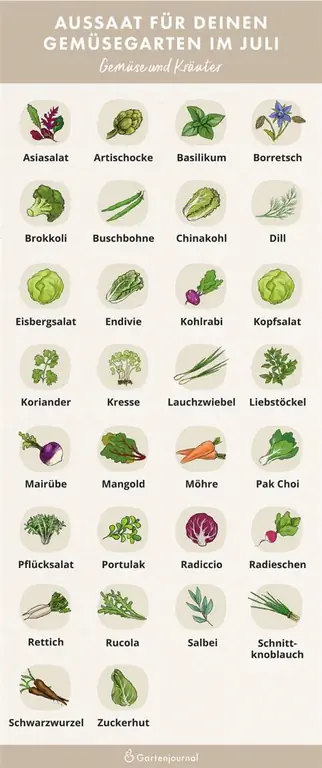
Harvests in July
July is particularly important because it begins the main season for harvesting vegetables, berries and herbs and preserving them in the garden.
Vegetables: Beans, peas, cucumbers, lettuce, zucchini, carrots and spinach are now being harvested continuously. Early cabbage, spring onions and sweet corn are also already ripe. These garden delicacies taste best when they are freshly prepared in the kitchen. Harvest surpluses can be preserved by freezing or cooking.
Herbs: Many herbs have now reached the peak of their development and some are about to bloom. They are rich in flavoring and healing ingredients and should be harvested and preserved shortly before flowering. Now is the time for lemon balm, tarragon, hyssop, boar's rue, mugwort, savory, oregano and marjoram. Hang to dry in a shady, not too hot place.
Berries: July is the month of berries: strawberries, raspberries, currants and gooseberries are now ripe and can be eaten fresh from the bush or preserved. If there are plenty of them, the vitamin-rich berries can also be frozen or made into jam. But be careful: Birds also love the ripe, sweet berries, so you should hang nets over bushes and trees. Strawberries can still be harvested in abundance in July, but towards the end of the month the harvest time for the sweet fruits gradually comes to an end.
Fruit: Cherries in particular ripen in July, and in warm locations, peaches, apricots and early apple varieties also ripen.
Flowering plants in July
July is a highlight in the summer garden when many flowers and bushes are in full bloom. The splendor and diversity of summer flowers and perennials is particularly impressive this month.
- Flowers: Dahlias, gladioli, bluebells, cornflowers, snapdragons, busy lilies, marigolds, cosmos, foxgloves
- Perennials: some peonies, clematis florida, clematis orientalis, girl's eye, mallow, phlox, larkspur, coneflower, glossy, daylily
- Grasses: Feather grass, riding grass, pennisetum grass, sandpipe, switchgrass, beach grass, hair grass
- Trees: Trumpet tree, silver lime, Gleditschie
- Shrubs and hedges: Hydrangeas, roses, privet, honeysuckle, bush chestnut
- Herbs: Oregano, hyssop, curry herb, clary sage, lavender, thyme, sage, lemon balm, chamomile, basil
Planting and propagating in July
In July it is still possible to bring both vegetables and certain ornamental plants into the garden. This time is also ideal for propagating some plant species through cuttings.
Planting early vegetables: Do you still have early vegetable plants? Then you can now fill the gaps in the beds caused by the harvest, for example with endive, ice lettuce, lettuce, kohlrabi, kale, savoy cabbage and cauliflower. Beds that are no longer to be planted can be sown with green manure.
Planting irises and peonies: The best time to plant irises and peonies is after flowering. Old, bare stands of irises should also be dug up and divided now. Then plant the young outer shoots again, cutting back the leaves a little beforehand. Old peony bushes, on the other hand, should no longer be moved; they usually do not tolerate such a move well. New irises and peonies will be available from July in perennial nurseries with a corresponding range, although it is advisable to order in advance, especially for new and popular varieties.
Propagate plants through cuttings: Many garden plants can be propagated through head and shoot cuttings, for which the months of July and August are particularly suitable. However, make sure to always keep the tender cuttings moist and to root them in a protected, partially shaded and not too warm place.
Cutting in July
July is the time to prune certain fruit trees and berry bushes after harvest to improve their he alth, appearance and productivity.
Berry bushes: After harvesting, cut off the removed raspberry canes low to the ground, except for the double-bearing varieties - these produce berries again in autumn. Currants and gooseberries, on the other hand, are only thinned out after the harvest. Tie up young shoots of blackberries and guide them, cut back shoots in the leaf axils to two leaves.
Fruit trees: After the harvest, cherry trees - and other early-ripening fruit varieties such as apricots and peaches - should be thinned out. In summer, remove branches that are growing too densely inside the crown so that the trees get light and air again. Summer pruning is particularly important for morello cherries, because these varieties support annual wood - and this forms after pruning.
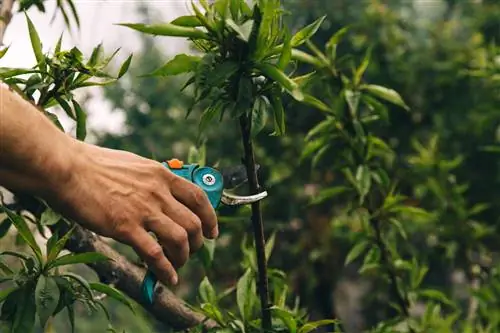
Peach trees can also be cut back immediately after harvest.
Deciduous hedges: Deciduous hedges, such as barberries, can be cut as early as July as long as there are no bird's nests in them. Therefore, before cutting, look carefully for nests with clutches or young birds and wait before cutting if you find any.
Summer flowers: For perennials and annual summer flowers, regularly cut off spent flowers to encourage further blooms. With a targeted cut, this works particularly well with lavender and catnip. Every seed formation costs the plants energy and prevents the formation of new flower buds. Balcony and potted plants can also be cleaned regularly.
Plant diseases and pests in July
Unfortunately, with summer and increased plant activity comes a number of plant diseases and pests that could reduce your harvest. In July, you should keep an eye on potential threats and take appropriate preventive measures.
Tomatoes and potatoes: At the first signs of late blight on potatoes or late blight on tomatoes, immediately remove all diseased leaves. Spray as a preventive measure with skimmed milk, horsetail broth, garlic or onion peel tea. Foil roofs or greenhouse crops protect the tomatoes from rain and thus from infections.
Useful and ornamental plants: Agricultural and ornamental plants are particularly threatened by fungal diseases in the summer months. Spray with horsetail broth as a preventive measure.
Pome and stone fruit: At the first sign of fruit monilia, collect and destroy all affected fruits or dispose of them in organic or household waste. Cut off and burn diseased branch tips of branch monilia. Under no circumstances should you throw infected plant parts into the compost!
Raspberries: To prevent raspberry cane disease, cut off all harvested raspberry canes to protect the plant from raspberry cane disease. Here you will find instructions for cutting summer and autumn raspberries.
More gardening work in July
Midsummer requires special attention to your garden. While the plants are in their flowering and growth phase, you must perform a series of tasks to ensure their he alth and productivity.
Fertilizing: Heavy-feeding vegetable plants in particular now need a strong supply of nutrients for a rich fruit set. Therefore, water tomatoes, zucchini, cucumbers, peppers, celery, leeks and all types of cabbage with fresh nettle manure every two weeks. Rhubarb and asparagus also enjoy this fertilization. Perennials and roses also receive another portion of organic fertilizer.
Watering: Regular watering is very important now in midsummer. However, be careful not to wet the leaves - this promotes fungal diseases - but rather to water directly into the root area of the plants. It is also better to water vigorously, but less often - then the roots will grow deeper. In addition, watering should be done in the early morning hours if possible. At midday the water evaporates very quickly, so more water is needed, and in the evening watering attracts hungry snails.
Mulching: July is usually a hot and dry month. Therefore, mulch beds and containers while the soil is still moist. Always replace the protective ground cover as it rots quickly. Grass clippings, crushed nettles and comfrey leaves are particularly suitable. The mulch layer keeps the soil moist for a long time because it reduces evaporation. It also provides the plants with additional nutrients during the decomposition process.
Mowing the lawn and flower meadow: Make sure to mow the lawn at larger intervals in midsummer. Don't cut the grass too short either, as the blades dry out easily in the heat. If you have created a flower meadow, July is the right time to mow. Best with the scythe.
Care for strawberry plants: After the strawberry harvest, cut back the foliage of the plants so that new, he althy leaves sprout. In addition, the strawberry plants must be fertilized heavily now so that they grow vigorously until autumn and remontant varieties form new flower heads. Also take the first strong plants from well-bearing mother plants and plant them in a new strawberry bed.
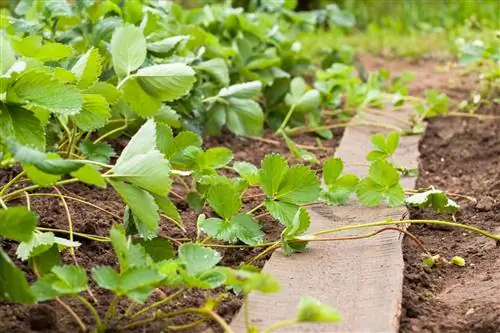
Strawberries reproduce through self-rooting children.
Care for balcony and pot plants: Provide balcony and pot plants regularly with water and fertilizer. Fertilization with an (organic) liquid fertilizer should be done once a week.
FAQ
What gardening work will be done in July?
In addition to harvesting, fertilizing, watering and weeding, the soil in the beds must be loosened and mulched to protect it from drying out. Harvested areas can be sown with green manure. Lawns and flower meadows must be mowed and diseases and pests must be combated or prevented.
What is sown in July?
In July the beds are empty again and can be refilled: bush beans, carrots, winter radish, radishes, beetroot, vegetable fennel, spinach, lettuce, sugar loaf lettuce, Chinese cabbage and spring onions as well as winter herbs (parsley, spoonwort, St. Barbara's cabbage, winter purslane, caraway) can still be sown now. For next year's flowers, you should also sow biennial summer flowers and perennials now.
What do you plant in July?
Pre-grown vegetable plants (e.g. endive, ice lettuce, lettuce, kohlrabi, kale, savoy cabbage, cauliflower) can be planted in the freely harvested bed gaps. July is also the right time to plant or transplant new irises and peonies into borders.
What will be cut in July?
After the harvest, cherry trees and other early-ripening fruit trees such as apricots and peaches in particular should be cut. Berry bushes should also be cut back: cut raspberry canes back to just above the ground, and only thin out currants and gooseberries. Spent summer flowers and perennials should also be cleaned out regularly to encourage renewed blooming.
Which plants can be propagated in July?
In July you can cut and root head and shoot cuttings from various garden plants and separate children from high-yielding strawberry plants and plant them in a new bed. In addition, old and bare strawberry plants can

